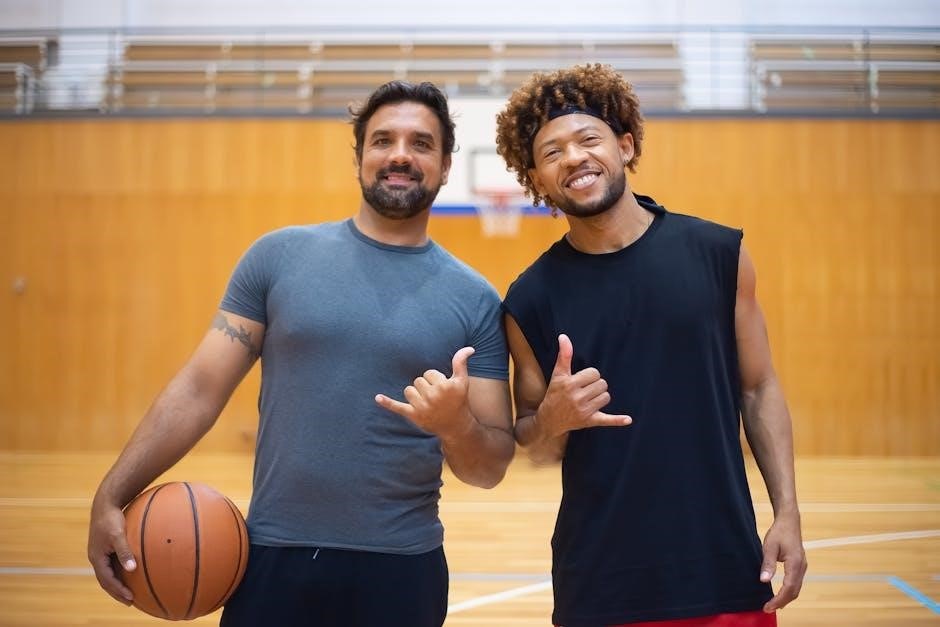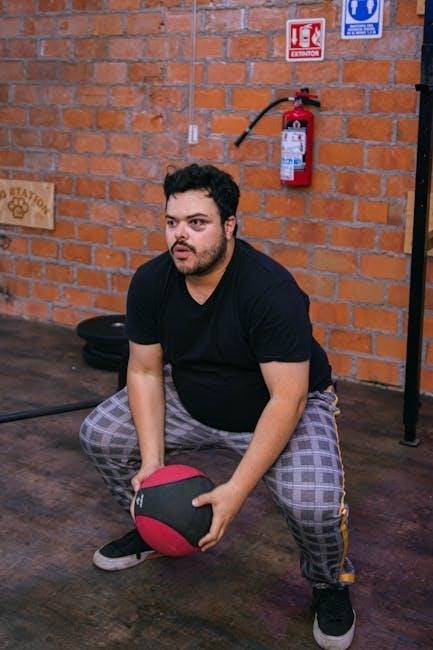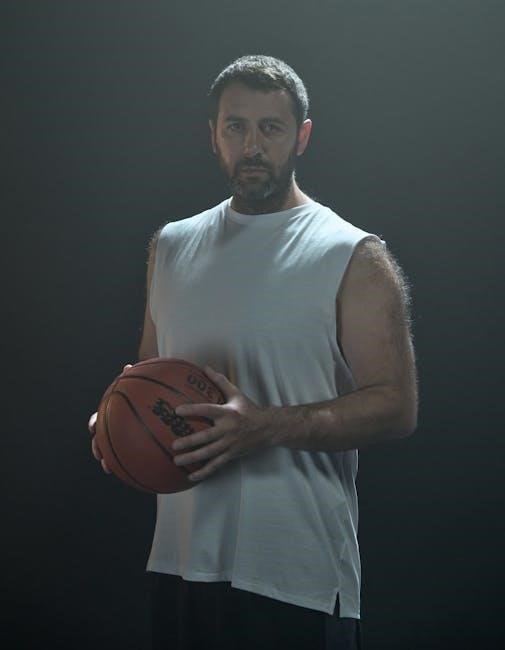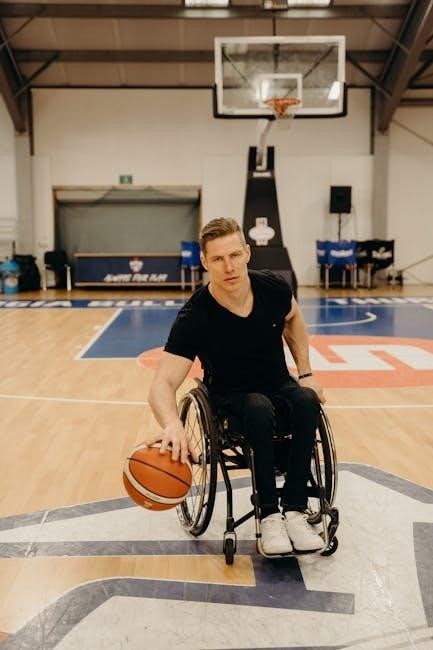Overview of the Basketball Workout Plan
A structured basketball workout plan enhances physical and skill development, combining conditioning, strength, and skill drills. PDF guides offer organized routines for optimal performance and progression tracking.
1.1 Importance of a Structured Workout Plan
A structured basketball workout plan ensures consistency, helping players build endurance, strength, and skill progressively. It prevents injuries by focusing on proper techniques and balanced development. A well-organized plan allows athletes to target specific areas, such as conditioning, shooting, and agility, while tracking improvement over time. For in-season play, it maintains performance levels, while off-season plans enhance overall athleticism.Structured routines also foster discipline and accountability, essential for achieving long-term goals. By following a detailed plan, players can maximize their potential and prepare effectively for competition, ensuring they are physically and mentally ready to perform at their best.
1.2 Benefits of a Basketball Workout Plan PDF
A basketball workout plan PDF offers a convenient and organized approach to training. It provides detailed routines, including conditioning, strength exercises, and skill-specific drills, all in one accessible format. PDF guides are easy to share and follow, making them ideal for both players and coaches. They often include progress tracking tools, nutritional advice, and injury prevention tips, ensuring a comprehensive approach to development. With a PDF, athletes can stay motivated and consistent, whether training at home, in the gym, or on the court, helping them achieve their goals efficiently.

Components of an Effective Basketball Workout Plan
A well-rounded basketball workout plan includes conditioning, strength training, skill drills, flexibility exercises, and core development. These elements work together to enhance performance and durability on the court.
2.1 Conditioning and Cardiovascular Training
Conditioning and cardiovascular training are essential for building endurance and stamina in basketball. Drills like jump-the-line exercises, sit-ups, and push-ups improve overall fitness. Cardio sessions, lasting 20-25 minutes, enhance heart health and longevity on the court. These routines ensure players maintain energy levels throughout games and practices, reducing fatigue. Proper conditioning also supports quick recoveries and sustained performance. Incorporating these exercises into daily workouts helps players meet the physical demands of basketball effectively, ensuring they stay competitive and resilient throughout the season.
2.2 Strength and Power Development
Strength and power development are critical for basketball players to enhance explosiveness and durability. Weightlifting, plyometrics, and resistance exercises target key muscle groups, improving jumping ability and acceleration. Core exercises like planks and medicine ball workouts stabilize the body, reducing injury risks. Leg workouts, including squats and lunges, build lower-body strength for powerful drives and jumps. These routines also enhance overall athleticism, allowing players to dominate on the court. A well-structured strength program ensures players can perform at peak levels while maintaining long-term physical resilience and performance consistency throughout the season.
2.3 Skill-Specific Drills (Dribbling, Shooting, Passing)
Skill-specific drills are essential for improving basketball fundamentals. Dribbling exercises focus on ball control, speed, and agility, such as figure-eight and crossovers. Shooting drills enhance accuracy and range, including spot-up shots and off-the-dribble techniques. Passing workouts emphasize precision and court vision, incorporating chest passes, bounce passes, and long outlet passes. These drills are structured to simulate game situations, helping players develop muscle memory and confidence. PDF guides provide detailed routines, ensuring players can practice effectively and consistently to refine their skills and elevate team performance.
2.4 Flexibility and Mobility Exercises
Flexibility and mobility exercises are crucial for basketball players to maintain range of motion and prevent injuries. Dynamic stretching, such as leg swings and arm circles, prepares muscles for activity. Static stretches target hamstrings, quads, and hip flexors to improve flexibility. Mobility drills, including lunges and calf raises, enhance joint movement. Incorporating these exercises into daily routines ensures better performance and reduces injury risk. PDF guides often include detailed stretching plans, making it easy for players to follow structured flexibility programs and maintain optimal physical condition throughout the season.

Daily and Weekly Workout Structure
A balanced basketball workout plan includes daily routines focusing on skill development, strength, and conditioning, with weekly schedules tailored to peak performance and recovery needs.
3.1 Sample Daily Workout Routine
A typical day begins with a 10-minute warm-up, including dynamic stretches and light cardio. Skill drills follow, focusing on dribbling and shooting for 20 minutes. Strength training involves leg workouts, sit-ups, and push-ups for 25 minutes. Conditioning activities like jump-the-lines and sprints are next for 15 minutes. The session concludes with 10 minutes of cool-down stretching and a review of progress. This balanced approach ensures improvement in endurance, strength, and basketball-specific skills, preparing players for both practice and competition while preventing injuries through structured routines.
3.2 Weekly Periodization for Optimal Progress
A weekly periodized basketball workout plan divides training into focused phases, each targeting specific skills and physical attributes. For example, Week 1 might focus on building foundational endurance and strength, with conditioning drills like jump-the-lines and core exercises. Week 2 could emphasize skill development, such as dribbling and shooting drills. Weeks 3 and 4 might introduce more intense strength and power workouts, along with advanced tactical plays. This structured approach ensures gradual progression, preventing plateaus and overtraining while enhancing overall performance. Each phase builds on the previous one, leading to peak readiness for competition.
In-Season vs. Off-Season Training
In-season workouts maintain conditioning and tactical focus, while off-season training emphasizes building strength, endurance, and skill development for optimal performance and injury prevention through a structured approach.
4.1 Adjusting Workouts for In-Season Play
During the season, workouts focus on maintaining conditioning and refining skills rather than building strength. Drills like jump-the-line and dynamic warm-ups improve agility and reaction. Players engage in situational shooting and tactical exercises to enhance game readiness. Conditioning activities such as sit-ups and push-ups are incorporated to sustain endurance. Recovery is prioritized with cool-down stretches and hydration. The intensity is adjusted to avoid overtraining, ensuring players stay fresh for games. Tailored workouts address individual needs while aligning with team strategies, fostering a balanced approach to performance and longevity throughout the season.
4.2 Focusing on Strength and Endurance in the Off-Season
The off-season is crucial for building strength and endurance. Workouts emphasize core exercises, medicine ball training, and on-court strength drills to enhance power and stability. Players engage in leg workouts, sit-ups, and push-ups to improve muscular endurance. Conditioning activities like jump-the-line and dynamic warm-ups boost agility and stamina. These sessions are designed to prevent injuries and prepare athletes for the physical demands of the upcoming season. By focusing on foundational strength and endurance, players develop the resilience needed for peak performance, ensuring they return to the court stronger and more prepared than ever.

Youth Basketball Workout Plan
A youth basketball workout plan focuses on age-specific drills and skill development, ensuring young athletes build a strong foundation through structured and progressive training sessions.
5.1 Age-Specific Drills and Exercises
Youth basketball workouts should be tailored to age groups, focusing on skill development and physical readiness. For younger players, emphasis is placed on basic dribbling, shooting, and passing drills. As players grow, exercises progress to more complex movements, such as advanced ball handling and agility training. Core strength and flexibility are introduced early to build a strong foundation; Age-specific plans ensure drills are appropriate for developmental stages, fostering growth and confidence. For teens, the focus shifts to combining skills with conditioning for game readiness. Each drill is designed to enhance performance while preventing injuries.Structured progression ensures long-term development.
5.2 Sample Practice Plans for Young Athletes
Sample practice plans for young athletes provide structured sessions, balancing skill development and fun. Each plan includes warm-ups, skill drills, and game scenarios. For example, a 60-minute session might start with 10 minutes of dynamic stretching and ball handling, followed by 20 minutes of shooting and passing drills. The next 20 minutes focus on defensive techniques and teamwork exercises. The final 10 minutes involve cool-down stretching and reviewing the session. These plans are adaptable to different age groups and skill levels, ensuring engagement and improvement. They also include tips for coaches to create a positive and effective learning environment. Consistency is key.

Core and Functional Training
Core and functional training enhances stability, balance, and overall basketball performance. These exercises improve strength, agility, and endurance, essential for dynamic movements on the court.
6.1 Core Exercises for Stability and Balance
Core exercises are vital for stability and balance, enhancing overall basketball performance. Planks, Russian twists, and medicine ball workouts target the abdominals and obliques. These exercises improve posture, reduce injury risk, and boost explosiveness on the court. Incorporating dynamic movements like rotational tosses and core-specific drills strengthens the trunk, enabling better control during jumps and quick direction changes. A strong core also enhances endurance, allowing players to maintain peak performance throughout the game. For detailed routines, the Medicine Ball Workouts and On Court Strength Workout PDFs provide comprehensive guides.
6.2 Functional Movements for Basketball Performance
Functional movements are essential for basketball, mimicking game situations to improve efficiency. Exercises like lateral shuffles, box jumps, and step-ups enhance agility and explosiveness. These drills replicate court actions, ensuring players can quickly change direction and maintain balance. Medicine ball tosses and rotational movements strengthen the core and improve reaction time; Functional training also reduces injury risk by reinforcing proper movement patterns. The Medicine Ball Workouts PDF offers detailed routines, while the On Court Strength Workout provides drills to integrate these movements into a competitive edge, ensuring players are game-ready and perform at their best.

Injury Prevention and Recovery
Injury prevention and recovery are crucial for basketball performance. Warm-ups, cool-downs, and proper hydration reduce injury risk. Recovery strategies like stretching and foam rolling aid muscle repair.
7.1 Warm-Up and Cool-Down Routines
A proper warm-up prepares the body for physical activity, reducing injury risk and improving performance. Dynamic stretches, such as high knees and arm circles, increase blood flow and flexibility. Incorporate light cardio like jogging or jump rope for 10-15 minutes. Post-workout, a cool-down with static stretches, such as hamstring and quad stretches, helps muscles recover. Include core exercises like planks to maintain stability and balance. Finish with breathing techniques to relax the mind and body, ensuring a smooth transition post-exercise. Consistent warm-up and cool-down routines are essential for long-term athletic development and injury prevention. Proper form and duration are key for maximum benefits.
7.2 Strategies for Preventing Common Basketball Injuries
Preventing common basketball injuries requires a proactive approach. Strengthening key areas like ankles, knees, and shoulders through targeted exercises reduces injury risk. Incorporate balance drills, such as single-leg stands, to improve stability. Proper warm-up and cool-down routines are crucial to prepare and recover muscles. Wearing appropriate footwear and using supportive gear, like knee braces, adds protection. Encourage players to focus on proper landing and jumping techniques to minimize stress on joints. A well-structured workout plan, including core exercises and flexibility training, helps build resilience and prevents overuse injuries, ensuring long-term player health and performance.

Nutrition and Hydration
Proper nutrition and hydration are vital for optimal performance. Meal planning ensures balanced intake of protein, complex carbs, and healthy fats. Stay hydrated to maintain energy and focus during workouts.
8.1 Meal Planning for Athletes
Meal planning is crucial for basketball players to fuel their bodies for optimal performance. A balanced diet rich in lean proteins, complex carbs, and healthy fats supports energy and recovery. Athletes should focus on whole foods like chicken, fish, whole grains, and vegetables. Hydration is also key, with water and electrolyte-rich drinks essential for performance. Meals should be timed around workouts, with a pre-game meal high in carbs and protein, and a post-workout meal to aid recovery. Proper nutrition enhances endurance, strength, and mental clarity, ensuring players perform at their best.
8.2 Importance of Proper Hydration
Proper hydration is essential for basketball players to maintain peak performance. Water makes up a significant portion of muscle tissue and is crucial for energy production. Even mild dehydration can lead to fatigue, decreased focus, and muscle cramps, hindering performance. Players should drink at least 8-10 glasses of water daily, increasing intake before, during, and after games or practices. Sports drinks can help replenish lost electrolytes during intense sessions. Monitoring hydration levels by checking urine color is a simple way to ensure they’re adequately hydrated. Staying hydrated supports recovery, prevents injuries, and enhances overall basketball performance.

Mental Preparation and Mindset
Mental preparation is crucial for basketball success. Techniques like visualization, positive affirmations, and mindfulness build confidence and focus, enhancing on-court performance and decision-making under pressure.
9.1 Building Confidence and Focus
Building confidence and focus is essential for peak basketball performance. Techniques like visualization, positive affirmations, and mindfulness help players stay mentally tough. Visualization allows athletes to mentally rehearse game scenarios, fostering confidence in decision-making. Positive affirmations reinforce self-belief, while mindfulness improves concentration during high-pressure moments. Incorporating these practices into daily routines enhances resilience and mental clarity. Coaches and players can use these tools to cultivate a winning mindset, enabling better execution of skills and strategies during games. Consistency in mental training ensures sustained growth and adaptability in competitive environments.
9.2 Visualization Techniques for Enhanced Performance
Visualization is a powerful tool to enhance basketball performance by mentally rehearsing plays and outcomes; Players imagine themselves succeeding in specific scenarios, such as making shots or defending effectively. This technique improves focus, reduces game-day anxiety, and builds mental resilience. Athletes are encouraged to set clear, achievable goals and visualize achieving them. Regular practice strengthens the mind-body connection, allowing for more instinctive decision-making during games. Coaches often incorporate visualization into pre-game routines to prepare players mentally. Consistent use of this technique can lead to improved confidence and execution on the court.

Monitoring Progress and Adjusting the Plan
Regularly track performance metrics like speed, strength, and endurance to assess improvement. Adjust workouts based on results to ensure continuous progress and avoid plateaus.
10.1 Tracking Performance Metrics
Tracking performance metrics is crucial for monitoring progress in a basketball workout plan. Key metrics include vertical jump height, sprint times, shooting accuracy, and endurance levels. Regular assessments help identify strengths and areas needing improvement. Use tools like stopwatches and scorekeeping to measure progress; Maintain a log to track improvements over time. This data helps adjust the workout plan to optimize results and tailor training to individual needs. Consistent tracking ensures athletes stay motivated and focused on their goals, ultimately enhancing overall performance on the court.
10.2 When and How to Modify the Workout Plan
Modify the workout plan based on progress, performance metrics, and seasonal demands. Adjustments should occur when plateaus are reached or when transitioning between phases, such as in-season to off-season. Increase intensity, duration, or complexity of drills as athletes improve. Incorporate new exercises to target specific weaknesses identified through performance tracking. Flexibility in the plan ensures it remains effective and tailored to individual or team needs. Regularly review and update the plan to align with evolving goals and physical conditioning requirements, keeping athletes engaged and motivated throughout their training journey.

Additional Resources and Tools
Explore recommended basketball workout PDFs, eBooks, and online courses for advanced training. Resources like Medicine Ball Workouts and On Court Strength guides enhance your routine effectively.
11.1 Recommended PDF Guides and eBooks
Enhance your training with trusted basketball workout plan PDFs. The “Sweat it Out” guide combines conditioning and shooting drills, while “Youth Basketball Drills” offers age-specific practices. For core strength, “Medicine Ball Workouts” and “On Court Strength Workout” PDFs are excellent. These resources provide structured routines, skill development, and injury prevention strategies. They cater to both in-season and off-season training, ensuring comprehensive athlete development. Access these guides through platforms like Shop.StrongerTeam.com for a well-rounded training approach.
11.2 Online Courses and Expert-Coaching Programs
Supplement your training with online courses and expert-coaching programs tailored for basketball. Platforms like the Championship Coaching Course offer comprehensive training modules, combining video tutorials, personalized feedback, and structured workout plans. These programs often include access to expert coaches who provide insights on skill development, conditioning, and game strategy. Many courses are designed for both players and coaches, offering drills, meal plans, and recovery techniques. Websites like Shop.StrongerTeam.com and ymcanwnc.org provide additional resources, ensuring a well-rounded approach to basketball development. These programs are ideal for athletes seeking guided, high-level training.
The basketball workout plan is essential for improving performance. It combines conditioning, strength, and skill development. PDF guides provide structured routines and progress tracking effectively.
12.1 Key Takeaways from the Basketball Workout Plan
A well-structured basketball workout plan is essential for improving performance, preventing injuries, and building overall athleticism. Consistency, proper nutrition, and mental preparation are vital for success. Incorporate a mix of conditioning, strength training, and skill-specific drills to balance development. Use PDF guides for organized routines and progress tracking. Adjust workouts seasonally, focusing on endurance in-season and strength in the off-season. Prioritize core stability, flexibility, and functional movements for better court performance. Stay hydrated, fuel your body with the right foods, and maintain a positive mindset to achieve long-term goals and become a well-rounded player.

Leave a Reply
You must be logged in to post a comment.